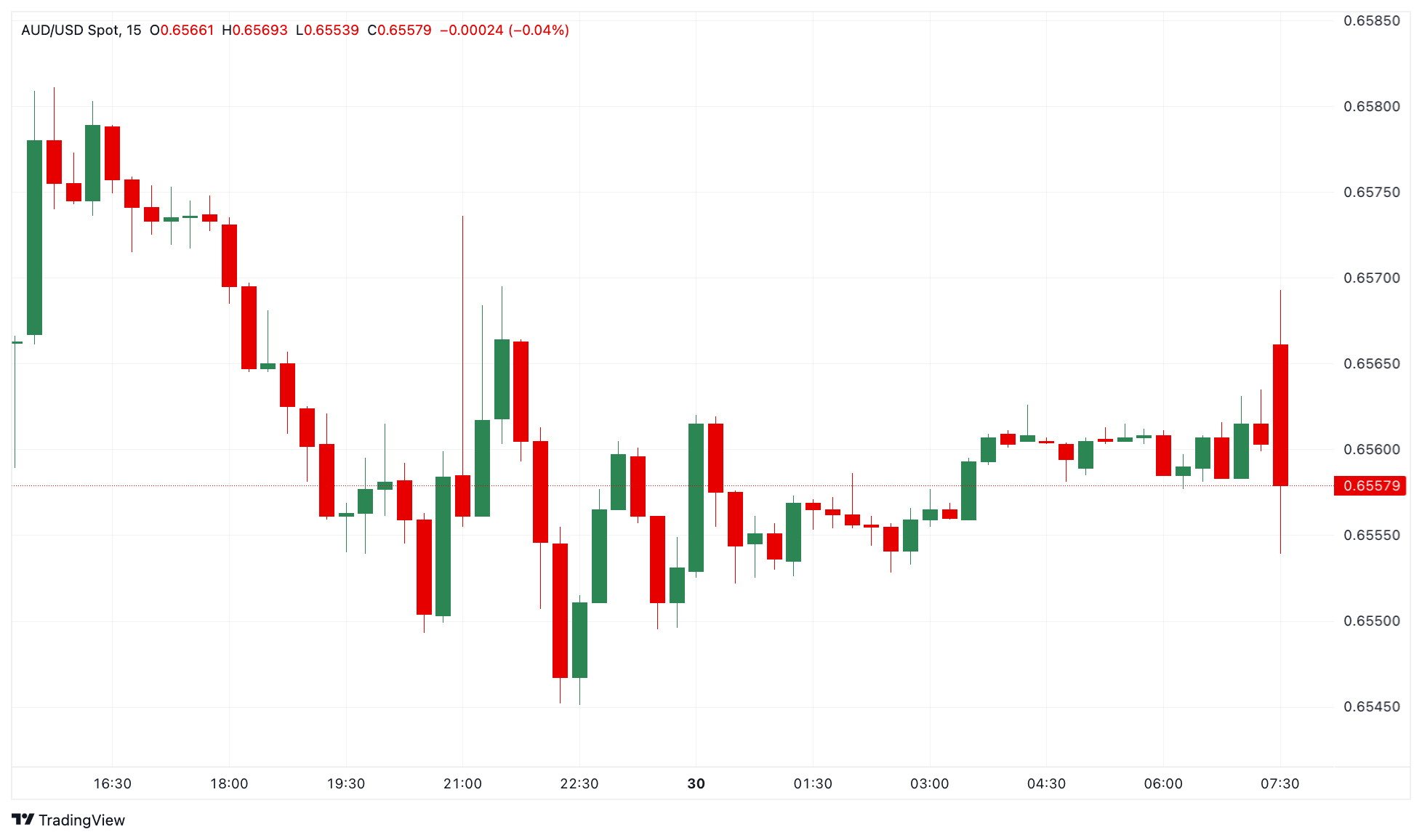Australia’s Consumer Price Index (CPI) rose 0.2% QoQ in the third quarter (Q3) of 2024, compared with the 1.0% increase seen in the second quarter, according to the latest data published by the Australian Bureau of Statistics (ABS) on Wednesday. The market consensus was for a growth of 0.3% in the reported period.
Annually, Australia’s CPI inflation fell to 2.8% in Q3 from the previous print of 3.8% and below the market consensus of 2.9%.
The RBA Trimmed Mean CPI for Q3 rose 0.8% and 3.5% on a quarterly and annual basis, respectively. Markets estimated an increase of 0.8% QoQ and 3.5% YoY in the quarter to September.
The monthly Consumer Price Index inflation dropped to 2.1% YoY in September versus 2.3% expected and the previous reading of 2.7% rise.
AUD/USD reaction to Australia's Consumer Price Index data
The AUD/USD pair edges lower following the inflation data from Australia. The pair is losing 0.05% on the day to trade at 0.6557, at the press time.
Australian Dollar price in the last 7 days
The table below shows the percentage change of Australian Dollar (AUD) against listed major currencies in the last 7 days. Australian Dollar was the weakest against the Euro.
| USD | EUR | GBP | CAD | AUD | JPY | NZD | CHF | |
| USD | -0.24% | -0.23% | 0.68% | 1.93% | 1.29% | 1.30% | 0.17% | |
| EUR | 0.24% | 0.00% | 0.92% | 2.11% | 1.53% | 1.54% | 0.41% | |
| GBP | 0.23% | -0.01% | 0.92% | 2.10% | 1.52% | 1.53% | 0.39% | |
| CAD | -0.69% | -0.92% | -0.91% | 1.21% | 0.61% | 0.63% | -0.52% | |
| AUD | -1.97% | -2.19% | -2.15% | -1.24% | -0.60% | -0.59% | -1.79% | |
| JPY | -1.31% | -1.59% | -1.55% | -0.64% | 0.53% | 0.01% | -1.15% | |
| NZD | -1.30% | -1.55% | -1.58% | -0.62% | 0.58% | 0.00% | -1.20% | |
| CHF | -0.17% | -0.41% | -0.39% | 0.52% | 1.71% | 1.13% | 1.14% |
The heat map shows percentage changes of major currencies against each other. The base currency is picked from the left column, while the quote currency is picked from the top row. For example, if you pick the Euro from the left column and move along the horizontal line to the Japanese Yen, the percentage change displayed in the box will represent EUR (base)/JPY (quote).
This section below was published at 21:30 GMT as a preview of the Australian inflation data.
- The Australian Monthly Consumer Price Index is foreseen at 2.3% in September.
- Quarterly CPI inflation expected below 3%, but core figures are still seen as too high.
- The Reserve Bank of Australia will meet in early November to decide on monetary policy.
- The Australian Dollar could find some near-term demand on higher-than-anticipated CPI readings.
Australia will publish fresh inflation-related figures on Wednesday, kick-starting a row of global first-tier releases that should grant volatility across the FX board. Ahead of the announcement, the Australian Dollar (AUD) fell to a nearly three-month low against the US Dollar (USD), with the latter benefiting from prevalent demand for safety.
The Australian Bureau of Statistics (ABS) will publish two different inflation gauges: the quarterly Consumer Price Index (CPI) for the third quarter of 2024 and the September Monthly CPI, which measures annual price pressures over the past twelve months. The quarterly report includes the Trimmed Mean Consumer Price Index, the Reserve Bank of Australia's (RBA) favorite inflation gauge.
The RBA will have a monetary policy meeting next week and the outcome will be announced on November 5. The Australian central bank has kept the Official Cash Rate (OCR) steady at 4.35% for roughly a year, and a rate cut remains out of sight.
What to expect from Australia’s inflation rate numbers?
The ABS is expected to report that the Monthly CPI rose by 2.3% in the year to September, easing from the 2.7% posted in August. The quarterly CPI is foreseen to increase by 0.3% quarter-on-quarter (QoQ) and by 2.9% year-on-year (YoY) in the third quarter of the year. Finally, the central bank’s preferred gauge, the RBA Trimmed Mean CPI, is expected to rise by 3.5% YoY in Q3, easing from the 3.9% advance posted in the previous quarter.
Inflationary pressures in Australia are receding after a rough first quarter of 2024 and are now expected to fall into the RBA’s target range of 2% to 3%. Nevertheless, Australian policymakers have repeated multiple times that inflation remains high and would not be sustainable within target for “another year or two.” With that in mind, an interest rate cut before 2025 remains out of the picture.
Easing inflationary pressures, however, should boost the odds for a soon-to-come interest rate trim, particularly considering shrinking growth. The Australian economy has not fallen into recession but it is close to it. Only government spending has prevented the country from suffering a steeper setback. The latest Gross Domestic Product (GDP) showed the economy grew by 0.2% QoQ and by 1.0% YoY in the three months to June.
In September, following the RBA’s latest monetary policy meeting, Governor Michele Bullock noted that while inflation “has fallen substantially since the peak in 2022”, it remains above the RBA’s preferred range of 2% to 3%. Bullock highlighted that underlying inflation was higher at 3.9% over the year to the June quarter. The focus will then be on core CPI as it remains closer to 4% than the magical 3% top goal.
An uptick in price pressures will likely push the odds for an interest-rate cut further away. The hawkish tone of policymakers will reinforce this idea, resulting in a stronger AUD. However, its strength remains doubtful, given the global scenario that keeps pushing investors toward safe-haven assets.
How could the Consumer Price Index report affect AUD/USD?
As previously noted, the RBA will meet next week and announce its decision on November 5. Market participants won’t expect action, but policymakers will acknowledge inflation levels and hopefully hint where they are heading next.
Generally speaking, higher CPI figures will be AUD bullish amid expectations for a persistently hawkish RBA. The opposite scenario is less likely: inflation may ease, but that won’t grant policymakers shifting towards a more dovish stance.
Heading into the CPI release, the AUD/USD pair trades below the 0.6600 mark, down for a third consecutive day.
Valeria Bednarik, FXStreet Chief Analyst, says: “The AUD/USD pair is not done with its slump, and regardless of the AUD’s reaction to the CPI, the risk is skewed to the downside. A recovery post-inflation data release could allow sellers to add shorts. From a technical perspective, the daily chart shows that AUD/USD is developing below all its moving averages. The 20 Simple Moving Average (SMA) heads south almost vertically and is about to cross below a directionless 100 SMA. The 200 SMA also stands flat, providing resistance at around 0.6630. Finally, technical indicators remain within negative levels, although with uneven bearish strength.”
Bednarik adds: “The AUD/USD pair has an immediate support area at around 0.6550, where it posted daily highs and lows between May and July. A break below this region should favor a bearish extension towards the 0.6500 threshold, while once the latter gives up, sellers could target the 0.6400-0.6430 area. Near-term resistance lies at 0.6630, en route to the 0.6670 area. Further gains could result in a test of the 0.6710 area, yet sellers will likely take their chances around it.”
Economic Indicator
RBA Trimmed Mean CPI (YoY)
The Consumer Price Index (CPI), released by the Australian Bureau of Statistics on a quarterly basis, measures the changes in the price of a fixed basket of goods and services acquired by household consumers The YoY reading compares prices in the reference quarter to the same quarter a year earlier. The trimmed mean, which is a measure of underlying inflation, is calculated as the weighted average of the central 70% of the quarterly price change distribution of all CPI components in order to smooth the data from the more-volatile components.Generally, a high reading is seen as bullish for the Australian Dollar (AUD), while a low reading is seen as bearish.
Read more.Next release: Wed Oct 30, 2024 00:30
Frequency: Quarterly
Consensus: 3.5%
Previous: 3.9%
Source: Australian Bureau of Statistics
The quarterly Consumer Price Index (CPI) published by the Australian Bureau of Statistics (ABS) has a significant impact on the market and the AUD valuation. The gauge is closely watched by the Reserve Bank of Australia (RBA), in order to achieve its inflation mandate, which has major monetary policy implications. Rising consumer prices tend to be AUD bullish, as the RBA could hike interest rates to maintain its inflation target. The data is released nearly 25 days after the quarter ends.
Inflation FAQs
Inflation measures the rise in the price of a representative basket of goods and services. Headline inflation is usually expressed as a percentage change on a month-on-month (MoM) and year-on-year (YoY) basis. Core inflation excludes more volatile elements such as food and fuel which can fluctuate because of geopolitical and seasonal factors. Core inflation is the figure economists focus on and is the level targeted by central banks, which are mandated to keep inflation at a manageable level, usually around 2%.
The Consumer Price Index (CPI) measures the change in prices of a basket of goods and services over a period of time. It is usually expressed as a percentage change on a month-on-month (MoM) and year-on-year (YoY) basis. Core CPI is the figure targeted by central banks as it excludes volatile food and fuel inputs. When Core CPI rises above 2% it usually results in higher interest rates and vice versa when it falls below 2%. Since higher interest rates are positive for a currency, higher inflation usually results in a stronger currency. The opposite is true when inflation falls.
Although it may seem counter-intuitive, high inflation in a country pushes up the value of its currency and vice versa for lower inflation. This is because the central bank will normally raise interest rates to combat the higher inflation, which attract more global capital inflows from investors looking for a lucrative place to park their money.
Formerly, Gold was the asset investors turned to in times of high inflation because it preserved its value, and whilst investors will often still buy Gold for its safe-haven properties in times of extreme market turmoil, this is not the case most of the time. This is because when inflation is high, central banks will put up interest rates to combat it. Higher interest rates are negative for Gold because they increase the opportunity-cost of holding Gold vis-a-vis an interest-bearing asset or placing the money in a cash deposit account. On the flipside, lower inflation tends to be positive for Gold as it brings interest rates down, making the bright metal a more viable investment alternative.
Information on these pages contains forward-looking statements that involve risks and uncertainties. Markets and instruments profiled on this page are for informational purposes only and should not in any way come across as a recommendation to buy or sell in these assets. You should do your own thorough research before making any investment decisions. FXStreet does not in any way guarantee that this information is free from mistakes, errors, or material misstatements. It also does not guarantee that this information is of a timely nature. Investing in Open Markets involves a great deal of risk, including the loss of all or a portion of your investment, as well as emotional distress. All risks, losses and costs associated with investing, including total loss of principal, are your responsibility. The views and opinions expressed in this article are those of the authors and do not necessarily reflect the official policy or position of FXStreet nor its advertisers. The author will not be held responsible for information that is found at the end of links posted on this page.
If not otherwise explicitly mentioned in the body of the article, at the time of writing, the author has no position in any stock mentioned in this article and no business relationship with any company mentioned. The author has not received compensation for writing this article, other than from FXStreet.
FXStreet and the author do not provide personalized recommendations. The author makes no representations as to the accuracy, completeness, or suitability of this information. FXStreet and the author will not be liable for any errors, omissions or any losses, injuries or damages arising from this information and its display or use. Errors and omissions excepted.
The author and FXStreet are not registered investment advisors and nothing in this article is intended to be investment advice.
Recommended content
Editors’ Picks

AUD/USD remains weak below 0.6300 despite upbeat Chinese PMI data
The AUD/USD pair remains under selling pressure around 0.6280 during the early Asian session on Thursday. The Australian Dollar pares losses against the Greenback after the stronger Chinese economic data. However, the upside might be limited as US President Donald Trump announced sweeping global reciprocal tariffs, prompting traders to turn cautious.

USD/JPY slumps to three-week low amid Trump's tariffs-inspired risk-off impulse
USD/JPY dives to a three-week low during the Asian session on Thursday as Trump's sweeping trade tariffs provide a strong boost to traditional safe-haven assets. The anti-risk flow triggers a steep decline in the US Treasury bond yields, which drags the USD back closer to a multi-month low touched in March.

Gold price hits fresh all-time peak in reaction to Trump's tariffs
Gold price spiked to a fresh record high on Thursday as investors grew increasingly concerned over the economic impact of Trump’s sweeping tariffs. This triggers a global risk-aversion trade and boosts the safe-haven bullion. Fed rate cut bets, declining US bond yields, and heavy USD selling benefits the non-yielding yellow metal.

Bitcoin and top altcoins slide as Trump kicks off reciprocal tariffs
Bitcoin and the entire crypto market saw a quick correction on Wednesday following President Donald Trump's reciprocal tariff announcements based on half of each country's respective rates.

Trump’s “Liberation Day” tariffs on the way
United States (US) President Donald Trump’s self-styled “Liberation Day” has finally arrived. After four straight failures to kick off Donald Trump’s “day one” tariffs that were supposed to be implemented when President Trump assumed office 72 days ago, Trump’s team is slated to finally unveil a sweeping, lopsided package of “reciprocal” tariffs.

The Best brokers to trade EUR/USD
SPONSORED Discover the top brokers for trading EUR/USD in 2025. Our list features brokers with competitive spreads, fast execution, and powerful platforms. Whether you're a beginner or an expert, find the right partner to navigate the dynamic Forex market.


